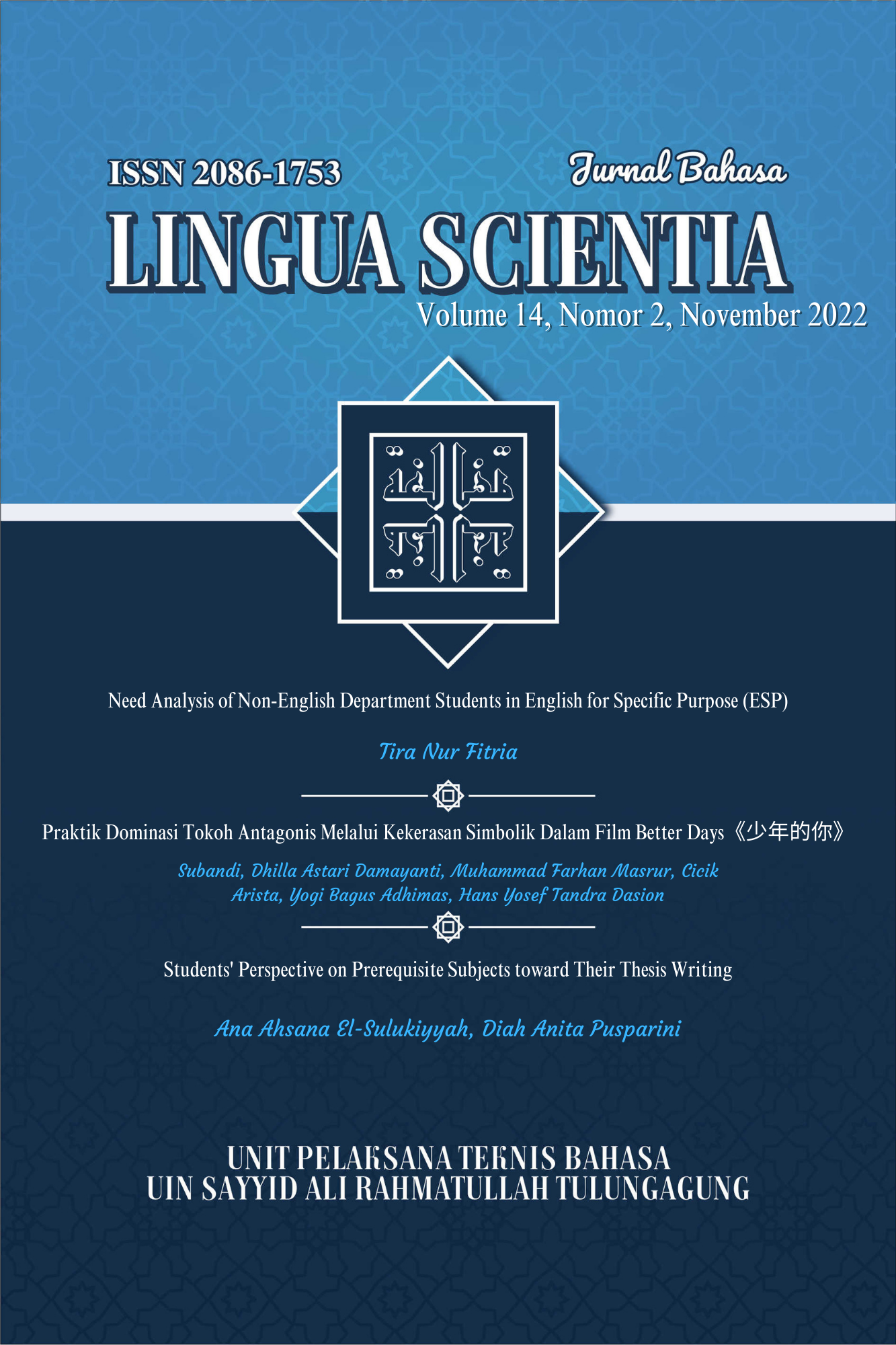NEED ANALYSIS OF NON-ENGLISH DEPARTMENT STUDENTS IN ENGLISH FOR SPECIFIC PURPOSE (ESP)
Abstract
This research is to investigate the need analysis of the non-English students in ESP. This research is descriptive and qualitative. The findings show that in the educational students’ background in high school from 348 students as respondents, most students (196 students or 56.3 %) graduated from Vocational High School. They think that the career opportunities available to tertiary education graduates are much wider and more numerous. Most students (259 students or 74.4 %) have a ‘Basic’ level. The students can use simple vocabulary/expressions in English, know a little grammar and make lots of pronunciation errors. Most students (232 students or 66.6 %) are motivated to learn English to have the ability in communicating orally in English and to get a good job after graduating from the study. Most students (231 students or 66.6 %) have difficulty understanding grammar’. Most students (250 students or 71.8 %) want to have the reading ability in looking for information on English text. Most students (283 students or 81.3 %) want to have the ability in writing English sentences properly and correctly. Most students (270 students or 77.6 %) want to have the ability in listening to and understanding English presentations from the lecturer. Most students (304 students or 87.4 %) want to have the speaking ability in pronouncing English words correctly. Related to English language material needs for specific purposes required by students, most students (303 students or 87.1 %) want the material of vocabulary, especially English specific terms in several references such as books, journal articles, textbooks, modules, or other sources according to their study program in the fields of Accounting, Taxation, Engineering and Information Systems, and Islamic Economics.
Downloads
References
Dörnyei, Z. (2014). Questionnaires in Second Language Research: Construction, Administration, and Processing. Routledge.
Downs, L. J. (2008). Listening Skills Training. American Society for Training and Development.
Fitria, T. N. (2019). Business English As a Part of Teaching English for Specific Purposes (ESP) to Economic Students. Jurnal Education and Economics, 2(02), 143–152. http://jurnal.azharululum.sch.id/index.php/jee/article/view/51
Fitria, T. N. (2020). Teaching English for Specific Purposes (ESP) to the Students in English Language Teaching (ELT). JET ADI BUANA, 5(01), 55–66. https://doi.org/10.36456/jet.v5.n01.2020.2276
Housel, D. J. (2001). Developing Listening Skills. Teacher Created Resources.
Huhta, M., Vogt, K., Johnson, E., & Tulkki, H. (2013). Needs Analysis for Language Course Design: A Holistic Approach to ESP. Cambridge University Press.
Hutchinson, T., & Waters, A. (1987). English for Specific Purposes. Cambridge University Press.
Jones, D. (2006). English Pronouncing Dictionary. Cambridge University Press.
Klenke, K. (2008). Qualitative Research in the Study of Leadership. Emerald Group Publishing.
Kroeger, P. R. (2005). Analyzing Grammar: An Introduction. Cambridge University Press.
Lichtman, M. (2010). Qualitative Research in Education: A User’s Guide. SAGE.
Madkur, A. (2018). English for Specific Purposes: A Need Analysis on English Course in Islamic Banking Department. Lingua Cultura, 12(3), 221–226. https://doi.org/10.21512/lc.v12i3.3395
McDill, W. (2006). The 12 Essential Skills for Great Preaching. B&H Publishing Group.
McShane, S. (2005). Applying Research in Reading Instruction for Adults: First Steps for Teachers. National Institute for Literacy.
Meiristiani, N., & Ekawati, Y. N. (2018). Needs Analysis of Mechanical Engineering Students in Learning English for Specific Purposes. Research and Innovation in Language Learning, 1(3), 153–166. https://doi.org/10.33603/rill.v1i3.1297
Paltridge, B., & Starfield, S. (2012). The Handbook of English for Specific Purposes. John Wiley & Sons.
Richards, J. C., Richards, J. C., & Renandya, W. A. (2002). Methodology in Language Teaching: An Anthology of Current Practice. Cambridge University Press.
Setiawati, B. (2016). Need Analysis for Identifying ESP Materials for Medical Record Students in Apikes Citra Medika Surakarta. Kajian Linguistik Dan Sastra, 1(1), 62-72–72. http://journals.ums.ac.id/index.php/KLS/article/view/2479
Sulistio, P. H. (2016). Need Analysis of ESP (English For Specific Purposes) For Physics Students. Eduscience : Jurnal Ilmu Pendidikan, 1(2), Article 2. https://ejurnal.esaunggul.ac.id/index.php/EDU/article/view/1536
Syakur, A., Zainuddin, H. M., & Hasan, M. A. (2020). Needs Analysis English For Specific Purposes (ESP) For Vocational Pharmacy Students. Budapest International Research and Critics in Linguistics and Education (BirLE) Journal, 3(2), 724–733. https://doi.org/10.33258/birle.v3i2.901
Woodrow, L. (2017). Introducing Course Design in English for Specific Purposes. Routledge.
Copyright (c) 2022 Tira Nur Fitria

This work is licensed under a Creative Commons Attribution-NonCommercial 4.0 International License.
Before going to review process, all manuscripts will be checked that they are free from plagiarism practice using "Turnitin" software. If there is an indication of plagiarism, the manuscript will instantly be rejected.


